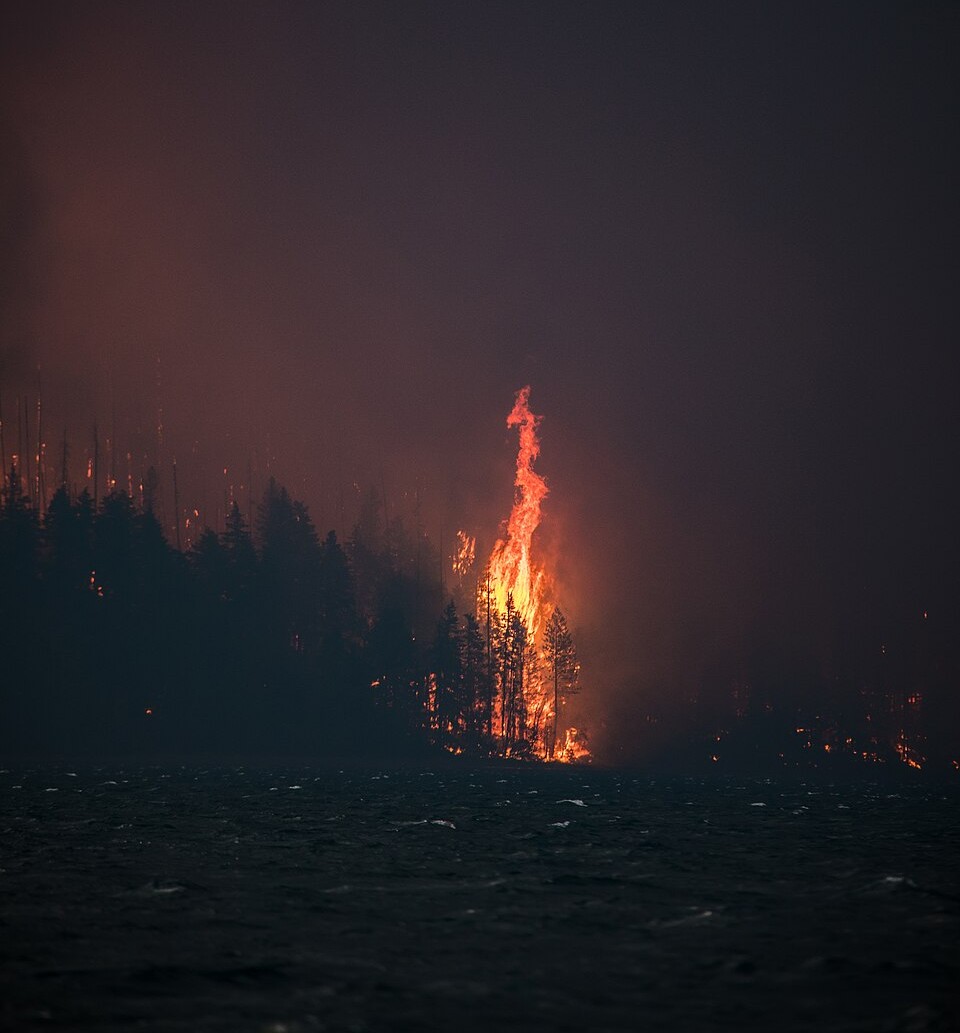New study finds increasing hot weather and lightning could spark more fires
10 September 2025

The Howe Ridge Fire seen from across Lake McDonald roughly 24 hours after the fire was started by a lightning strike. New study finds wildfires started by lightning will increase across 98% of western United States.
Credit: Glacier National Park Service
AGU press contact:
Liza Lester, [email protected] (UTC-4 hours)
Contact for researchers:
Dmitri Kalashnikov, [email protected] (UTC-7 hours)
WASHINGTON — Lightning will ignite more wildfires in the western United States in the coming decades as temperatures increase due to climate change, according to a new study that combined predictions for fire-friendly and lightning-friendly weather conditions.
In the western United States, lightning is responsible for more than two-thirds of the area burned by wildfires, and that number is only going to grow. Starting as early as 2031-2060, the study found essentially all of the western United States, or 98%, will see an increase in days posing a risk for lightning– started wildfires.
Areas that are already at high risk for wildfires started by lightning, such as Oregon, Idaho and Montana, are expected to see the largest increase in overall lightning days, with up to 12 more days per summer by 2060. Some areas, particularly in the U.S. Southwest, like Arizona, are expected to see a smaller increase as they will simply see less lightning.
The new study was published in Earth’s Future, AGU’s journal for interdisciplinary research on the past, present and future of our planet and its inhabitants.
“The first step was to project lightning,” said Dmitri Kalashnikov, research scientist at the University of California Merced and lead author on the study. “The typical climate models don’t directly simulate lightning. It’s too small a process.”
To get around this, Kalashnikov created his own machine-learning models that predict lightning based on the occurrence of weather variables that are typically found in climate models, such as the amount of moisture in the atmosphere. He published the models last year in AGU’s Journal of Geophysical Research: Atmospheres.
He combined his lightning models with the Fire Weather Index projections to predict the number of future days when conditions that encourage lightning and fire ignition and spread coincide.
The Canadian Forest Fire Weather Index, created in 1968, measures how favorable the weather is on a given day for wildfires. It keeps track of temperature, precipitation, humidity and other factors that could impact fires. For example, higher temperatures or lower precipitation, especially prolonged, can increase the chances of a fire.
While there have been previous models created for worldwide changes in lightning, Kalashnikov and his team created models that were specifically trained for locations in the western United States and for a closer timeframe. Their models focused on the years 2030 to 2060, compared to previous models that typically only looked at the end of the century.
Using the Fire Weather Index, researchers were able to predict how the number of days that have a high risk of wildfires will change over the coming decades.
The modeling found the northwestern United States was expected to see the largest increase in lightning days. Parts of Idaho, Oregon and Montana saw the largest increase in this cloud-to-ground lightning, or lightning that strikes the ground, which can ignite flammable vegetation. However, due to lesser increases in the Fire Weather Index, these areas will see slower increases in fire risk compared to areas farther south.
The southern half of the western United States still saw an increase in potential fires started by lightning, despite seeing a lower risk for lightning increases than the northern states. The increase is still projected because the entire West saw a general increase in high-risk days for wildfires as temperatures climb and the risk of droughts and heatwaves increase. In the south, Colorado, Wyoming, Arizona and New Mexico projected the largest increases in wildfires started by lightning.
Kalashnikov said next steps could expand what the models include, like bringing in rainfall amounts to differentiate between dry lightning and wet lightning, or lightning that happens with or without rain. This could help differentiate between thunderstorms that pose a risk of wildfires versus heavy-rain producing storms that could create flash flooding.
“You can’t help but wonder what the future will look like, especially if you dig in and you realize that there’s actually a lot that we don’t understand,” Kalashnikov said.
Notes for journalists:
This study is published in Earth’s Future, an open-access AGU journal. View and download a pdf of the study here. Neither this press release nor the study is under embargo.
Paper title:
“Projections of Lightning-Ignited Wildfire Risk in the Western United States”
Authors:
- Dmitri Kalashnikov, Sierra Nevada Research Institute, University of California, Merced, California, USA
- John Abatzoglou, Management of Complex Systems Department, University of California, Merced, California, USA
- Frances Davenport, Civil and Environmental Engineering, Colorado State University, Fort Collins, Colorado, USA
- Zachary Labe, NOAA OAR Geophysical Fluid Dynamics Laboratory, Princeton, New Jersey, USA
- Paul Loikith, Department of Geography, Portland State University, Portland, Oregon, USA
- Danielle Touma, Institute for Geophysics, University of Texas, Austin, Texas, USA
- Deepti Singh, School of the Environment, Washington State University, Vancouver, Washington, USA
AGU (www.agu.org) is a global community supporting more than half a million advocates and professionals in Earth and space sciences. Through broad and inclusive partnerships, AGU aims to advance discovery and solution science that accelerate knowledge and create solutions that are ethical, unbiased and respectful of communities and their values. Our programs include serving as a scholarly publisher, convening virtual and in-person events and providing career support. We live our values in everything we do, such as our net zero energy renovated building in Washington, D.C. and our Ethics and Equity Center, which fosters a diverse and inclusive geoscience community to ensure responsible conduct.
#
Contributed by Riley Thompson